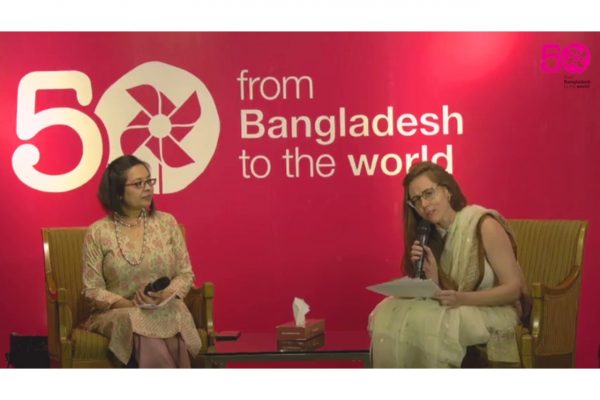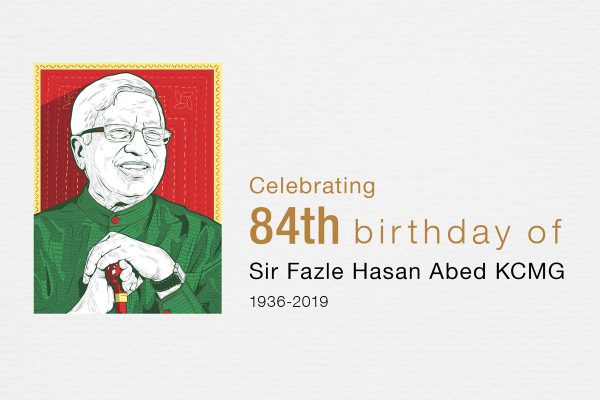Fast Company: BRAC Is The Largest Global Anti-Poverty Organization And It’s A Secret
Reading Time: 6 minutes
The following was originally posted by Alice Korngold on Fast Company. Alice Korngold is a Fast Company expert blogger, CEO of Korngold Consulting, and author of “Leveraging Good Will: Strenthening Non-profits by Engaging Businesses.”
The following was originally posted by Alice Korngold on Fast Company.
Alice Korngold is a Fast Company expert blogger, CEO of Korngold Consulting, and author of “Leveraging Good Will: Strenthening Non-profits by Engaging Businesses.”
Founded by former Shell Oil executive Fazle Hasan Abed in 1972, BRAC reaches 138 million of the poorest people in nine countries in Asia and Africa, and recently launched in Haiti. Its mission is to empower people and communities in situations of poverty, illiteracy, disease and social injustice. Its annual operating budget is half a billion dollars.
BRAC is one of the extraordinary organizations that is funded by the Omidyar Network (ON) and is participating in this week’s Omidyar Network Executive Forum (ONEF). See my accompanying post on “Omidyar Network Executive Forum Convening World’s Leading Social Entrepreneurs.”
For an organization of such magnitude and impact, BRAC’s brand is not commonly known.

BRAC provides microloans, self-employment opportunities, health services, education, and legal and human rights services
BRAC’s vision is a world free from all forms of exploitation and discrimination where everyone has the opportunity to realize their potential. Its interventions aim to alleviate poverty on a large scale through economic and social programs. BRAC has created 8.5 million self-employment opportunities and made $5 billion in micro-loans to over 6 million borrowers. BRAC’s schools graduated 3.8 million students from primary schools and 2.3 million from pre-primary schools, with nearly 1.8 million children currently enrolled in its 66,000 schools. You can read more here.
Originally known as the Bangladesh Rural Advancement Committee–now simply called BRAC–the organization was founded by Abed when he was overwhelmed by the sight of death and extreme poverty among refugees returning to Bangladesh after the 1971 Liberation War of Bangladesh. Abed left his corporate life, sold his London home to fund his project, and set up relief efforts in a remote area in northeastern Bangladesh. Next he raised funds from Oxfam to further advance the organization. Abed’s work ultimately led him and BRAC to deal with the long-term task of improving living conditions of the rural poor. He directed his policy towards helping the poor develop their capacity to manage and control their own destiny.
In “Freedom from Want,” author Ian Smillie notes that “[Abed] did not know that, in the years ahead, he would confront and surmount some of the greatest development challenges on the planet and everything he knew about economics, health, and education would be turned on its head.”
Smillie describes the unique BRAC culture that was established from the outset: “Brutally honest about what had been achieved and what [BRAC] had learned … The idea was not to prove they had all the answers before they started, but to find out what worked and apply the lessons.” From the beginning, BRAC let incompetent staff go and set up a training center for those who remained. As BRAC facilitated the development of small enterprises by the people they serve, BRAC sought and found ways to lower the costs of production in order to reduce the expenses of borrowing.
You’d think I’m writing about an ambitious, highly competitive company. And yet, I’m writing about what is referred to in The Economist “by most measures the largest, fastest-growing non-governmental organisation (NGO) in the world–and one of the most businesslike.”

BRAC’s approaches to poverty alleviation are entirely unique: “small is beautiful but big is necessary”.
My private interviews with Sal Giambanco, Partner, Omidyar Network (a primary BRAC funder) and Susan Davis, President & CEO, BRAC USA, reveal some of the key factors that make BRAC so uniquely effective in its holistic approach to poverty alleviation. BRAC has achieved so much because it:
1.Constantly tested, measured, and modified its solutions in order to maximize its effectiveness in solving poverty–from the very beginning. Never seeking to make its reports look better for funders, never assuming that it had the answers, always trying to find better solutions.
2.Engaged in the community to develop solutions together, not as an outside force thinking it had the answers and would drop resources onto the community and then leave.
3.Recognized the limits that government and religious and social norms placed on women, especially with regard to working, even though women were counted on to help support their families. Within those constraints, BRAC identified industries where women would be permitted to work (e.g., dairy), helped them set up microenterprises (through training and microlending), and also helped to find a way for the dairy products to reach the market.
4.Gradually developed a holistic approach in Bangladesh for three decades before replicating the model–first in Afghanistan 10 years ago. As BRAC developed through an iterative process, BRAC developed many interventions, coupling traditional microfinance loans with other programs like health care, education, human rights and legal services, and social enterprise. Its microfinance program targets the poorest of the poor, and adapts for the varied local contexts in which BRAC works.
5.Specifically designed programs–based on the concept of “massification”– that could be expanded exponentially to serve the large populations of poverty-stricken people in Bangladesh. This positioned BRAC to be particularly effective in other regions with dense populations of people living in extreme poverty. As Abed said, “Small is beautiful, but big is necessary.”
BRAC employs 125,000 people
BRAC employs 125,000 people–primarily women–in Asia and Africa. “We have a disciplined work culture, training and hiring first time job holders–mostly women, primarily high school and college graduates fresh out of school,” explained Davis. “As the largest international NGO, as a job-creator and employer of scale and diversity, we teach people the basics of customer service and how to be productive employees.” Not only do the jobs benefit people in the communities served by BRAC, but the revenues from BRAC industries (e.g., BRAC Dairy and Aarong retail chain) provide a good portion of BRAC’s earned income.
Southern leadership and South-to-South collaboration mean lower costs and higher impact BRAC’s experienced Bangladesh managers train new employees in Uganda, Tanzania, etc. The point is that new BRAC recruits learn that success is possible–from people from conditions they can relate to, rather than from Americans. An additional benefit is that the trainers get passports, travel, and return to their home country with new skill sets and perspectives.
BRAC’s strategy to scale up in new countries not only involves rigorous training, but also a promotion ladder to instill ambition and reward achievement among employees. Trainees who achieve as credit officers (community organizers) have the opportunity to be promoted to branch managers, then to area managers, and then to region managers. The pyramid scales to reach many employees and members of the community. The same training and promotion model is applied to schools, health, and other areas of BRAC service.

BRAC is creating new markets for products
BRAC has also trained 100,000 health and other promoters using an innovative micro-franchise-like approach to reaching “the last mile” (deep into remote communities) and generating self-employment. We might think of the promoters as “door-to-door sales people,” but in this case they are helping people with legal services (property rights), poultry and livestock services, energy services, etc. Promoters assist people in remote rural communities in learning about agriculture, family planning, how to protect themselves from deadly diseases and illnesses, and so on, while making a living for themselves. Note to companies: BRAC has enormous purchasing power.
“We know how to move people out of conditions that are sub-human”
Davis is emphatic. After giving vivid descriptions of the poorest of poor families whom she meets in her work, she is adamant that “we can eliminate absolute poverty. We’re rich enough. We know enough. BRAC serves the ‘ultra-poor,’ the most hungry, the most marginalized.” As we talked in her office last Friday, Davis became more contemplative as she commented that, “the relative poverty is more complicated. What’s good enough?”
“The heart of social entrepreneurship is a willingness to try out ideas that are helpful to others. Social entrepreneurs are action researchers: they learn primarily through experimentation,” say Davis and her co-author David Bornstein in “Social Entrepreneurship: What Everyone Needs to Know.” Davis and Bornstein are describing the many social entrepreneurs they discuss in their excellent book, but their comments fit Abed and BRAC quite perfectly. Davis and Bornstein also point out that “scaling an idea requires every bit as much entrepreneurship as piloting one.” As it enters its fourth decade, BRAC is succeeding in scaling its approaches.
BRAC has been a secret
No, not on purpose. BRAC has remained relatively unknown in the West (despite numerous awards given to Abed and BRAC) because it developed on the local level in the poorest, most remote communities of Bangladesh. Its programs were developed step-by-step as its organizers–people in the community–listened, learned, and enhanced and expanded services in order to create a holistic approach to help families to emerge from poverty and build better lives for themselves. BRAC’s growth is based on Southern leadership and South to South (as opposed to North to South) collaboration. And BRAC’s approach is complicated; a tagline doesn’t capture it.
Building awareness in the U.S. and UK to support a proven approach to alleviate poverty and empower tens of millions to build their lives
BRAC USA and BRAC UK were launched in 2007 to raise public awareness about the BRAC approach to sustainable human development and mobilize resources to enable BRAC to rapidly scale up its programs. Awareness-building and fundraising have become particularly urgent since Bangladesh does not allow foreign exchange to go out of the country; consequently, BRAC cannot use any of the revenues derived from its Bangladesh programs to launch new initiatives in other countries. As a result, BRAC’s fundraising initiatives will help the organization to seed new services to other parts of the world.
BRAC offers a proven approach that can be effectively scaled to alleviate poverty and empower tens of millions of people to build their lives–to establish businesses to support their families, educate themselves and their children, practice healthy lifestyles, and help the next generation to live better. This is an approach that governments, foundations, philanthropists, and individuals should get behind. And if it takes a bit to learn and explain the BRAC approach, I think we’re up to it. The secret needs to get out.
Want to help get the secret out? Click here.
Images:
1. Community health worker in Sudan: copyright BRAC/Shehzad Noorani
2. Bangladesh meeting: copyright Annie Escobar and Patricia Schneidewind
3. Training session in Tanzania: copyright BRAC/Shehzad Noorani





